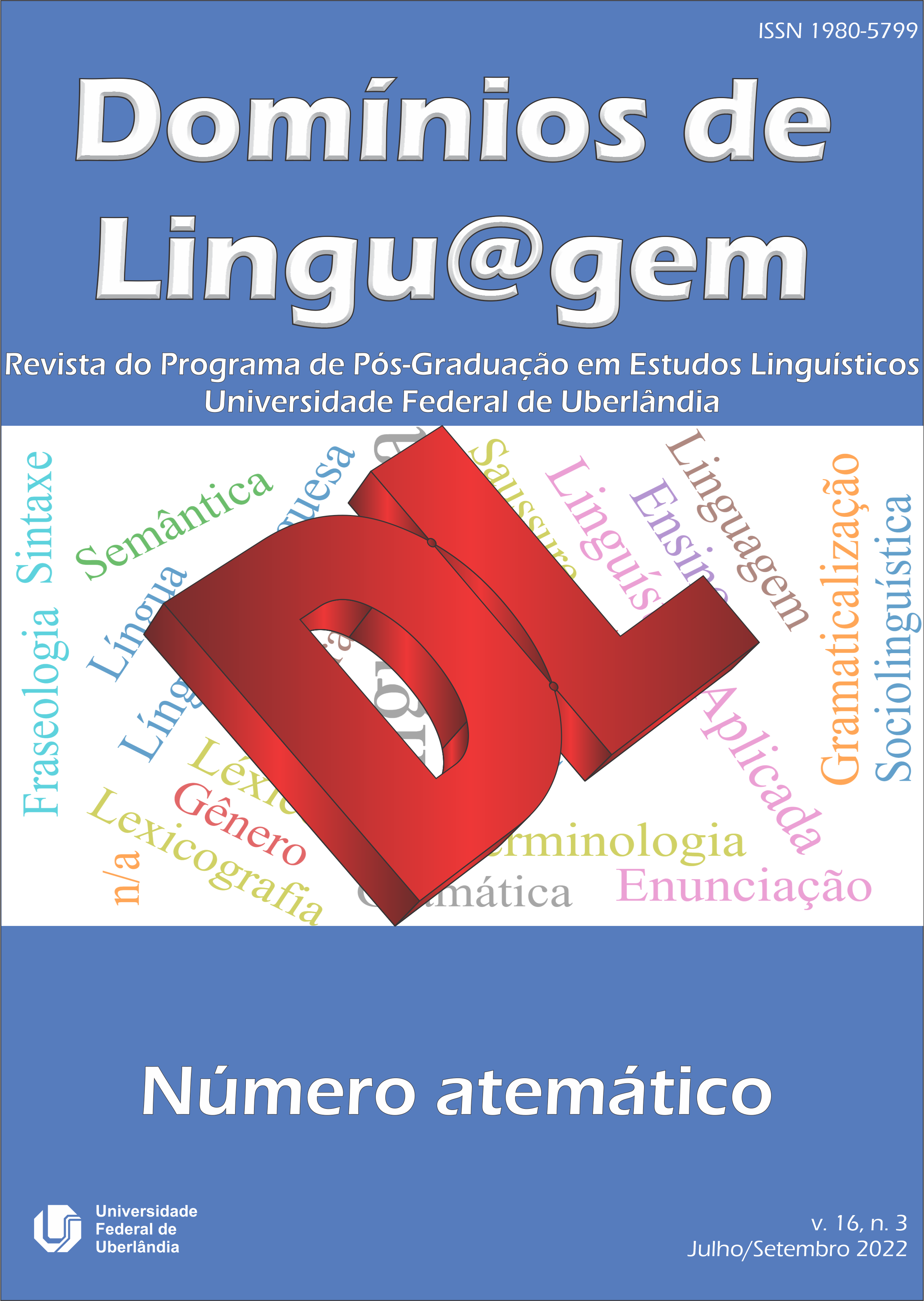Representações de experiências de quase morte
uma abordagem da Linguística de Corpus e da Análise Multidimensional
DOI:
https://doi.org/10.14393/DL51-v16n3a2022-6Palabras clave:
Experiências de quase morte, Linguística de Corpus, Análise MultidimensionalResumen
O objetivo deste artigo é a análise da variação das dimensões de relatos de Experiências de Quase Morte (EQM). Nas últimas décadas, diversas áreas do conhecimento têm investigado o fenômeno, desde o lançamento do livro de Moody (1975), dentre as quais a linguística. Nenhum estudo, até o presente momento, investigou sua variação de dimensões na língua inglesa, por meio da Linguística de Corpus (LC) (BERBER SARDINHA, 2004) e da Análise Multidimensional (AMD) (BIBER, 1988). Como método principal do estudo, usou-se a AMD aditiva (BIBER; CONRAD, 2001) e AMD completa (BIBER, 1988), a fim de mapear 1223 relatos nas dimensões de variação do inglês e desvendar suas dimensões próprias. Em relação à AMD aditiva, o corpus de estudo apresentou escore positivo nas dimensões um, dois e cinco e escore negativo nas dimensões três e quatro. Quanto à AMD completa, três dimensões funcionais foram identificadas e interpretadas como (1) Discurso relatado vs. Descrição elaborada, (2) Discurso Deôntico e (3) Discurso com enfoque no posicionamento.
Descargas
Referencias
BERBER SARDINHA, T. Linguística de Corpus: Histórico e Problemática. LAEL, São Paulo, v. 16, n. 2, p. 323–367, 2000a. DOI https://doi.org/10.1590/S0102-44502000000200005
BERBER SARDINHA, T. Análise Multidimensional. D.E.L.T.A., São Paulo, v. 16, n. 1, p. 99–127, 2000b. DOI https://doi.org/10.1590/S0102-44502000000100005
BERBER SARDINHA, T. Linguística de Corpus. São Paulo: Manole, 2004.
BIBER, D. Variation Across Speech and Writing. Cambridge: Cambridge Universtiy Press, 1988. DOI https://doi.org/10.1017/CBO9780511621024
BIBER, D. Multi-dimensional approaches. In: LÜDELING, A.; KYTÖ, M. Corpus linguistics: An international handbook volume 2, Berlin/New York: Walter de Gruyter, 2009.
BIBER, D.; CONRAD, S. Variation in English: Multi-Dimensional Studies. Harlow: Longman, 2001.
CHARLAND-VERVILLE, V. et al. Characterization of near death experiences using text mining analyses: A preliminary study. PLOS ONE, San Francisco, v. 15, n. 1, p. e0227402, 30 jan. 2020. DOI https://doi.org/10.1371/journal.pone.0227402
ENGMANN, B. Near-Death Experiences. Cham: Springer International Publishing, 2014. DOI https://doi.org/10.1007/978-3-319-03728-8
GREYSON, B. The near-death experience scale. Construction, reliability, and validity. Journal of Nervous & Mental Disease, v. 171, n. 6, p. 369–375, 1983a. DOI https://doi.org/10.1097/00005053-198306000-00007
GREYSON, B. The near-death experience scale. Journal of Nervous and Mental Disease, Baltimore, v. 171, n. 6, p. 369–375, 1983b. DOI https://doi.org/10.1097/00005053-198306000-00007
GREYSON, B. A Typology of Near-Death Experiences. American Journal of Psychiatry, Philadehphia, v. 142, n. 8, p. 967–969, 1985. DOI https://doi.org/10.1176/ajp.142.8.967
LANGE, R.; GREYSON, B.; HOURAN, J. Using computational linguistics to understand near-death experiences: Concurrent validity for the Near Death Experience Scale. Psychology of Consciousness: Theory, Research, and Practice, Washington, v. 2, n. 1, p. 79–89, mar. 2015. DOI https://doi.org/10.1037/cns0000040
LONG, J.; PERRY, P. Evidence of the Afterlife: The Science of Near-Death Experiences. New York: HarperCollins, 2010.
MARTIAL, C. et al. Neurochemical models of near-death experiences: A large-scale study based on the semantic similarity of written reports. Consciousness and Cognition, Amsterdam, v. 69, p. 52–69, mar. 2019. DOI https://doi.org/10.1016/j.concog.2019.01.011
MOODY, R. A. Life After Life: The Investigation of a Phenomenon-Survival of Bodily Death. Atlanta: Mockingbird Books, 1975.
MOODY, R. A. Getting comfortable with death & near-death experiences. Near-death experiences: an essay in medicine & philosophy. Missouri medicine, Missouri, v. 110, n. 5, p. 368-371, 2013.
MORSE, M.; PERRY, P. Closer To The Light. New York: Ballantine Books, 1991. DOI https://doi.org/10.1097/00006527-199121000-00013
PARNIA, S. et al. A qualitative and quantitative study of the incidence, features and aetiology of near death experiences in cardiac arrest survivors. Resuscitation, Amsterdam, v. 48, n.2, p. 149-156, 2001. DOI https://doi.org/10.1016/S0300-9572(00)00328-2
RING, K. Life at Death. New York: Coward, McCann & Geoghegan, 1980.
SABOM, M. B. The Near-Death Experience. The Journal of the American Medical Association, Chicago, v. 244, n. 1, p. 29-30, 1980. DOI https://doi.org/10.1001/jama.244.1.29a
ST CLAIR, M. Near-Death Experiences: A Historical Exploration from the Ancient World to the Present Day. United Kingdom: Amber Books Ltd, 2019.
VAN DER SLUIJS, M. Three Ancient Reports of Near-Death Experiennces: Bremmer Revisited. Journal of Near-Death Studies, North Carolina, v. 27, n. 4, p. 223–253, 2009.
VAN LOMMEL, P. et al. Near-death experience in survivors of cardiac arrest: A prospective study in the Netherlands. Lancet, Oxford, v.358, n. 9298 p. 2039-2045, 2001. DOI https://doi.org/10.1016/S0140-6736(01)07100-8
Descargas
Publicado
Número
Sección
Licencia
Derechos de autor 2022 Aline Andrea Zamboni Milanez, André Luiz Siqueira Alencar

Esta obra está bajo una licencia internacional Creative Commons Atribución-NoComercial-SinDerivadas 4.0.
Domínios de Lingu@gem utiliza la licencia Creative Commons (CC) CC BY-NC-ND 4.0, preservando así la integridad de los artículos en un ambiente de acceso abierto. La revista permite al autor conservar los derechos de publicación sin restricciones.









